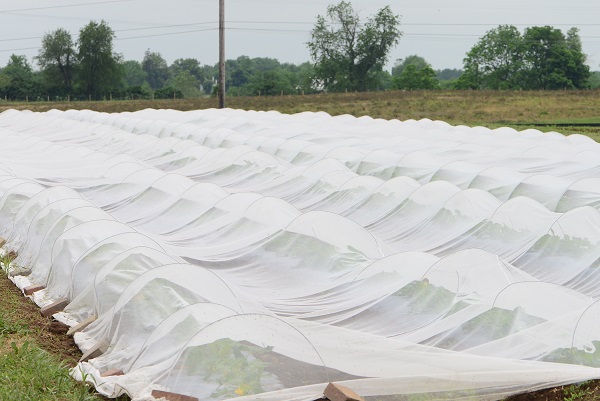Row Covers for Insect Management
ENTFACT-322: Row Covers for Insect Management | Download PDF
Ric Bessin, Extension Specialist
University of Kentucky College of Agriculture
Vegetable growers use row covers for a variety reasons, notably for frost protection in the spring or fall. But row covers can also be used to delay or prevent insects for colonizing high value plants. They are a viable option for organic, small-acreage, and mixed-vegetable farms. Row covers serve as a mechanical barrier the exclude insects from reaching the plants. Row covers are used to exclude a wide variety of insect pests and, in some instances, the diseases they transmit from young plants.

Figure 1. Row covers protect young plants from many insect pests.
There are several different types of fabric that can be used for row covering, but the material needs to be light, breathable, and durable. Many growers use what they can tobacco cloth (Remay) as it is economical, has the desired properties, and comes in wide rolls. Generally, row covers are put in place as soon as the crop is seeded or transplanted into the field. They are left in place over the crop until flowering or, in some instances, until after bloom. There are various configurations, with one or more rows being contained under a row cover, but row covers for insect management must be sealed along all of the edges to prevent insect entry. Pole, boards, even lay-flat irrigation hose filled with water can be used to hold down the edge of the row covers. In order for the technique to be effective, the row covers need to be completely sealed along all of the edges. Holes in the fabric should be repaired with tape when they appear.
Potential Problems
Wind can cause serious damage to row covers. Constant winds can work the edge of the fabric free from the weights that hold the side down and high winds can tear the fabric. Wind breaks can be used to slow the wind over the row cover and anchored straps can be used to hold the row covers in place and reduce buffeting by the winds.
Despite the barrier, on occasion, insect pests do get under the row cover. Under the row cover they are able to develop and reproduce in the absence of natural enemies. Temperatures under row covers may also promote more rapid development of the insects. When pests such as aphids, spider mites, or whiteflies get under the row, they build to higher populations much faster than they would without the row cover. For this reason, it is important to regularly monitor for pests under the row cover and take action if necessary. It is very important to do this regularly as considerable damage can be done in a short period of time by large pest populations. One possible action would be to remove the fabric to allow natural enemies of the pests to move onto the plants. Another tactic would be to introduce biological control agents into the system. Natural enemies of some pests can be purchased and released under the fabric. As a final alternative, the row covers could be pulled back to allow for an organic or conventional insecticide application, then carefully replaced.
Pollination
Some crops require insects for pollination. For example, the vining crops (cucurbits) are completely dependent on insects for pollination. Many growers will use row covers only until flowering, then they will remove the row covers. When the pollination period is over, row covers can be replaced. Some growers will open the ends of the rows when using low tunnels to an entry point for the pollinators, but the value of the row cover as a barrier is reduced. An additional alternative would be to place a commercial bumble bee colony under the rower cover to provide pollination. Growers may have mixed results using bumble bees underneath row covers. When using bumble bee colonies under the row cover, shade over the cardboard colony may be required to keep the colony from overheating. Colonies of bumble bees are expensive, so growers would need to at the cost versus potential return on the investment. Bumble bees would also need space between the top of the plants and the row cover, so a support or low tunnel system may be needed.
Issued: 11/19
CAUTION! Pesticide recommendations in this publication are registered for use in Kentucky, USA ONLY! The use of some products may not be legal in your state or country. Please check with your local county agent or regulatory official before using any pesticide mentioned in this publication.
Of course, ALWAYS READ AND FOLLOW LABEL DIRECTIONS FOR SAFE USE OF ANY PESTICIDE!
Photos courtesy Ric Bessin, University of Kentucky Entomology
